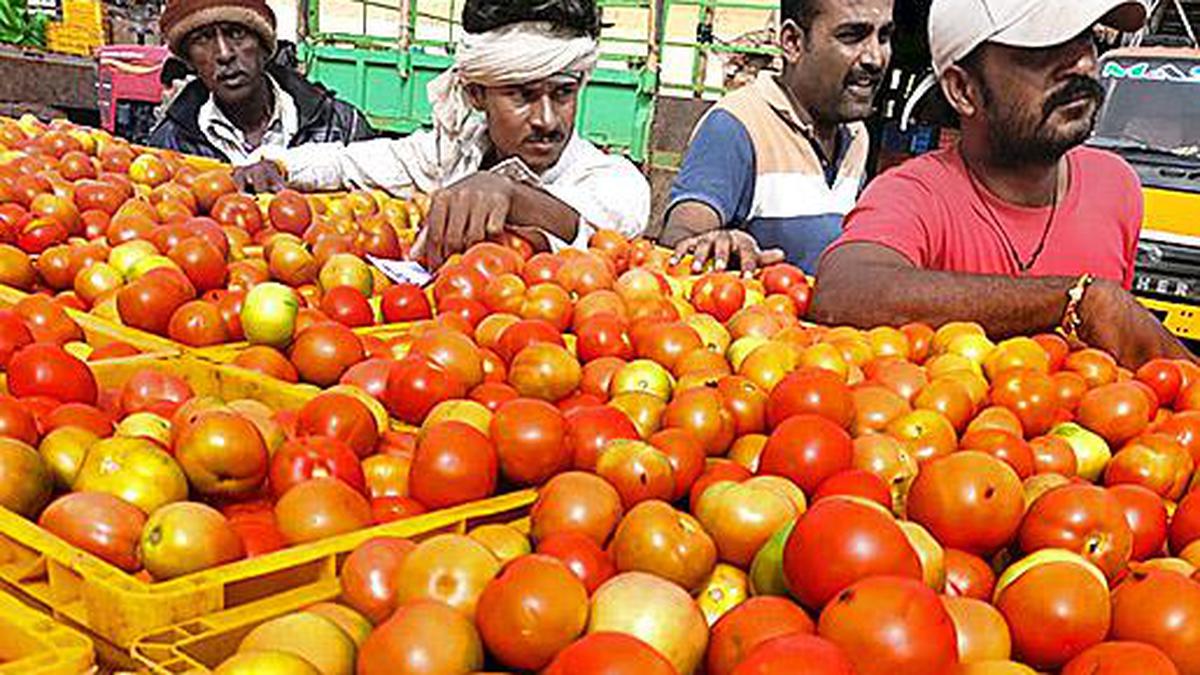Tomato inflation: The wholesale price of the tomatoes for the first-grade variety stood above Rs. 100 per kg in many parts of India by the last week of June
The sudden and rapid fall in the quantity of tomatoes brought to various mandis across India in the last week of June created a demand-supply mismatch. This led to a rapid increase in the retail price of the staple vegetable. The price of tomato zoomed past ₹100 per kilogramme (kg) mark on the last day of June in at least 50 cities, most of them in Uttar Pradesh, where the degree of fall in quantity at mandis was relatively high compared to other States.
Chart 1 | The chart shows the modal retail price of a kg of tomato in India in the past one month.
Chart appears incomplete? Click to remove AMP mode
Modal price is the price at which a kg of tomato is bought most frequently in markets across the country on a day. In the first 24 days of June, the modal price was ₹20 per kg. In the last week of June, the modal price surged to over ₹50 per kg. On the last day of the month, it peaked at ₹100 per kg.
The factors behind the abrupt fall in the quantity of tomatoes brought to mandis varied across India. In general, yield suffered due to relatively high temperatures during summer. Moreover, unusually sharp spells of rain in the northern States also impacted production. The fact that July-August is a lean production period compounded the problem. Reports show that many farmers in the Kolar district of Karnataka shifted to beans owing to the higher prices the vegetable fetched last year.
Click to subscribe to our Data newsletter.
Chart 2 | The chart plots the quantity of tomatoes (in tonnes) that were brought to mandis across India in the last week of June between 2020 and 2023.
This year, in the last week of June, 62,842 tonnes of tomatoes arrived at the mandis, the lowest in the last four years. In fact, this was over 50% and 80% lower than the quantity that arrived at mandis in June 2022 and 2021, respectively.
Chart 3 | The chart shows the quantity of tomatoes (in tonnes) that were brought to various mandis across India in the last four weeks of June 2023. (There were five weeks in June 2023).
The chart shows that in the second, third and fourth weeks, the quantity brought was at the expected level, but crashed suddenly in the last (fifth) week. Compared to the second, third and fourth weeks of June 2023, the quantity in the last week declined by 55%, 45% and 35%, respectively.
Chart 4 | The chart shows the sudden rise in tomato prices. It shows the average retail price of a kg of tomato in India in June between 2009 and 2023.
Despite the rapid increase in the retail prices in the last week of June 2023, the average price of tomato was only ₹32.5, given the much lower prices in the previous three weeks. This was lower than the average retail price of ₹52 per kg in June 2022. The June 2023 average price was also lower than the price in June 2019 and June 2016.
Chart 5 | The chart shows the quantity of tomatoes (in tonnes) brought to mandis across States in the last four weeks of June 2023. Data from Tamil Nadu was not available.
The quantity brought to mandis in Uttar Pradesh crashed from 12,500 tonnes in the second week to just over 5,300 tonnes in the last week — a 58% drop. This was the steepest drop among States. Maharashtra recorded a 52% drop while Andhra Pradesh saw a 31% decline.
Map 6 | The map shows the average retail price of a kg of tomato in rupees on June 30.
In 51 of the 473 cities analysed, the prices touched or crossed the ₹100 per kg mark. Thirteen of these were in Uttar Pradesh. Ahmednagar in Maharashtra recorded the highest average retail price (₹123 per kg) among the cities considered. Bellary in Karnataka, Kurnool in Andhra Pradesh, and Dhar in Madhya Pradesh are the other cities where the retail price crossed the ₹110 mark.
Source: agmarknet, the Ministry of Consumer Affairs, Food and Public Distribution and the National Horticulture Board
vignesh.r@thehindu.co.in and rebecca.varghese@thehindu.co.in
Also read | Data | Parsing the inflation story of the past year
Listen to our podcast |Hostile witness, doctored evidence, erring judges: Justice K. Chandru on why police are not convicted for custodial violence | Data Point podcast







